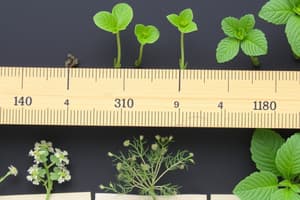Podcast
Questions and Answers
What is classification?
What is classification?
Classification is grouping living things together by a set of rules. These rules can be based on similarities or differences.
What makes a plant a plant?
What makes a plant a plant?
Plants are many celled and can make their own food. They are classified into two main groups: vascular and nonvascular.
What are nonvascular plants?
What are nonvascular plants?
Nonvascular plants, such as moss and liverworts, do not have tubes to carry water and food.
What are vascular plants?
What are vascular plants?
What are gymnosperms?
What are gymnosperms?
What are angiosperms?
What are angiosperms?
Give examples of non-vascular plants.
Give examples of non-vascular plants.
Give examples of vascular plants.
Give examples of vascular plants.
Give examples of gymnosperms.
Give examples of gymnosperms.
Give examples of angiosperms.
Give examples of angiosperms.
Which of the following plants would most likely grow lowest to the ground?
Which of the following plants would most likely grow lowest to the ground?
Flashcards are hidden until you start studying
Study Notes
Plant Classification Overview
- Classification groups living organisms based on similarities or differences, following specific rules.
- Example: Pine, fir, and spruce belong to the conifer group.
Characteristics of Plants
- Plants are multicellular organisms that can photosynthesize, creating their own food.
- Two main classifications: vascular and nonvascular plants.
Nonvascular Plants
- Include mosses and liverworts, lacking tubular systems to transport water and nutrients.
- Typically found in damp environments; they are small and grow close to the ground.
Vascular Plants
- Possess a network of tubes that distribute water, nutrients, and food.
- Capable of growing to large sizes due to this system.
Gymnosperms
- Defined as "naked seed" plants, these vascular plants do not have seeds that are protected by fruit.
- Examples: Pine, spruce, and fir trees are common gymnosperms.
Angiosperms
- Also known as flowering plants, angiosperms produce fruits that safeguard their seeds.
- This group encompasses a wide variety of plants, including those with colorful flowers.
Examples of Nonvascular Plants
- Moss
- Lichen
- Liverwort
Examples of Vascular Plants
- Pine Tree
- Apple Tree
- Fir Tree
- Tomato Plant
- Basil
- Grass
Examples of Gymnosperms
- Pine Tree
- Fir Tree
- Redwood Tree
- Spruce Tree
Examples of Angiosperms
- Apple Tree
- Tomato Plant
- Grapes
- Peach
- Zucchini
- Cantaloupe
- Sunflower
Growth Habitats
- Among listed plants, moss is most likely to grow lowest to the ground, highlighting its nonvascular nature.
Studying That Suits You
Use AI to generate personalized quizzes and flashcards to suit your learning preferences.




